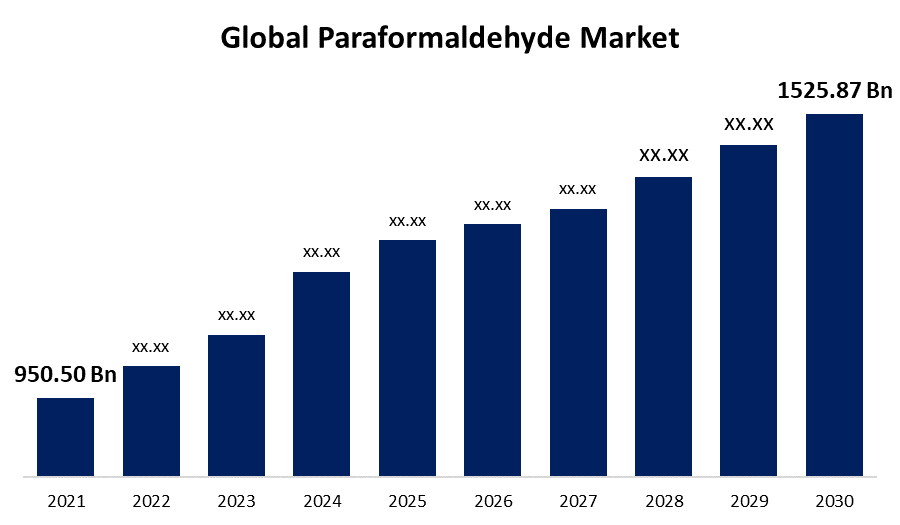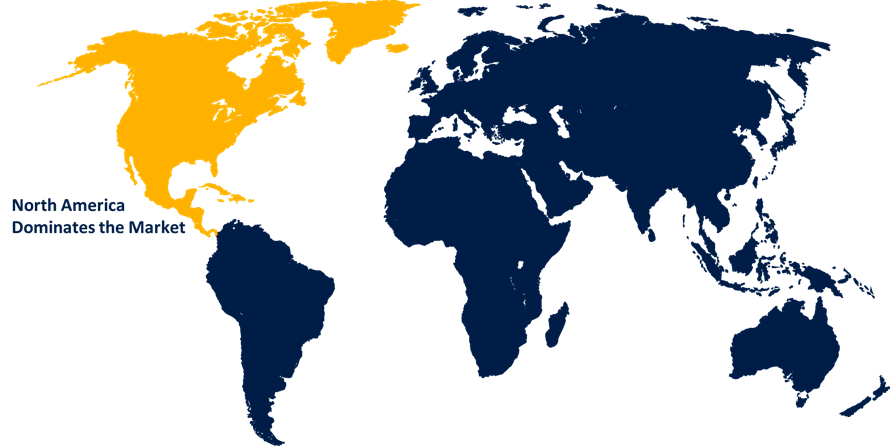Global Paraformaldehyde Market Size, Share, and COVID-19 Impact Analysis By Purity (91%-93% and 95%-97%), By Application (Resins, Agrochemicals, Medical, Photographic films, Papermaking, Paints & Coatings, Oil field chemicals, Lubricant additives and Others) and by Region (North America, Europe, Asia-Pacific, Latin America, Middle East and Africa), Analysis and Forecast 2021 - 2030
Industry: Chemicals & MaterialsGlobal Paraformaldehyde Market Insights Forecasts to 2030
- The Global Paraformaldehyde Market Size was valued at USD 950.50 Billion in 2021.
- The Market Size is Growing at a CAGR of 5.4% from 2022 to 2030
- The Global Paraformaldehyde Market Size is Expected to reach USD 1525.87 Billion by 2030
- Asia Pacific is Expected to Grow the fastest during the forecast period.

Get more details on this report -
The global Paraformaldehyde Market is expected to reach USD 1525.87 Billion by 2030, at a CAGR of 5.4% during the forecast period 2022 to 2030. The growing demand for paraformaldehyde in the agricultural sector, its expanding use in fumigants, disinfectants, fertilisers, and pesticides, its expanding use in pharmaceutical products, and its expanding use in printing & photography, personal care and household cleaning products, as well as intermediate additives and compounds, are the main factors enhancing the global Paraformaldehyde market's revenue growth.
Market Overview
The smallest polyoxymethylene formed during the polymerization of formaldehyde, known as paraformaldehyde (PFA), develops as a white precipitate in aqueous formaldehyde solutions when kept in a cold environment. This material, a poly-acetal, smells strongly like formaldehyde. It may be depolymerized into formaldehyde gas by dry heating and into a solution by adding water, an acid, or a base. These procedures provide high-purity formaldehyde solutions that are often employed in histology, pathology, and microscopy as fixatives. Paraformaldehyde is employed as a fumigant, fungicide, insecticide, and disinfectant in its depolymerized form. Additionally, paraformaldehyde may crosslink proteins to Deoxyribonucleic Acid (DNA), which is a specific method for identifying the regions of DNA that the proteins are interacting with. Paraformaldehyde is furthermore utilised in place of aqueous formaldehyde in the creation of resinous binding materials that are then combined with phenol, melamine, or other reactive substances to create particle board, plywood, and medium-density fiberboard. The increased demand for paraformaldehyde in the chemical, paints & coatings, papermaking, printing, oil & gas, and medical sectors is one of the reasons contributing to the worldwide paraformaldehyde market's significant revenue rise. In addition to being a disinfectant, paraformaldehyde is also a hardening and waterproofing agent. It is utilised in the production of plywood, furniture, agrochemicals such fertilisers, insecticides, and fungicides, as well as adhesives, lubricants, resins, thermoplastics, automotive topcoats & finishes. As finishing resins for paper and textiles, insulating varnishes for electrical components, driers and glossing agents for paints and coatings, and fixatives in cell culture research, paraformaldehyde also serves these functions. Over the forecast period, a number of negative aspects are anticipated to restrain the revenue growth of the worldwide paraformaldehyde market. One of the main barriers to this market's growth is the growing knowledge of paraformaldehyde's detrimental health consequences. Humans may have harmful health effects from prolonged exposure to powdered paraformaldehyde, including cancer, reproductive issues, and irritation or allergic reactions in the eyes, nose, upper respiratory tract, and mucous membranes. Other constraints anticipated to impede market revenue development include rising prices for high-purity paraformaldehyde and an increasing number of paraformaldehyde substitutes, including dialdehyde glyoxal. Due to its considerably lower toxicity, greater efficiency, and cheaper price, dialdehyde glyoxal can replace paraformaldehyde in biomedical applications like immunostaining of cells. The production of gas, oil, and other goods was disrupted due to a scarcity of competent personnel and raw resources. The market was harmed as a result. The market, however, is anticipated to quickly resume its normal course as the world begins to recover from the pandemic.
Report Coverage
This research report categorizes the Market for global Paraformaldehyde based on various segments and regions, forecasts revenue growth, and analyses trends in each submarket. The report analyses the key growth drivers, opportunities, and challenges influencing the Global Paraformaldehyde Market. Recent Market developments and competitive strategies such as expansion, Product launch and development, partnership, merger, and acquisition have been included to draw the competitive landscape in the Market. The report strategically identifies and profiles the key Market players and analyses their core competencies in each global Paraformaldehyde Market sub-segments.
Global Paraformaldehyde Market Report Coverage
| Report Coverage | Details |
|---|---|
| Base Year: | 2021 |
| Market Size in 2021: | USD 950.50 Billion |
| Forecast Period: | 2022-2030 |
| Forecast Period CAGR 2022-2030 : | 5.4% |
| 2030 Value Projection: | USD 1525.87 Billion |
| Historical Data for: | 2017-2020 |
| No. of Pages: | 203 |
| Tables, Charts & Figures: | 114 |
| Segments covered: | By Purity, By Application By Region, COVID-19 Impact Analysis |
| Companies covered:: | Ercros, CCP, Celanese, LCY Chemical, Nantong Jiangtian, Hebei Jintaida Chemical, Shangdong Aldehyde Chemical, Yinhe Chemical, Shouguang Xudong, LINYI TAIER, Merck, Mitsubishi Gas Chemical, Chemanol, Xiangrui Chemical, Caldic |
| Pitfalls & Challenges: | Due to the increasing number of COVID-19 cases |
Get more details on this report -
Segmentation Analysis
- In 2021, the 95%-97% segment accounted for the largest share of the Market, with 60.1% and a Market revenue of 571.25 Billion.
Based on the Purity, the Paraformaldehyde Market is categorized into 91%-93% and 95%-97%. In 2021, the 95%-97% segment accounted for the largest share of the Market, with 60.1% and a Market revenue of 571.25 Billion. Throughout the forecast period, the 95%-97% segment is anticipated to maintain its leading position because of an important factor influencing this segment's revenue growth is the expanding use of paraformaldehyde with a purity level of 95%–97% in agrochemicals like fumigants, fertilisers, fungicides, and pesticides. This is due to its robust properties, including high solubility, homogeneity, low acid content, good stability, and chemical resistance. Revenue growth is also anticipated to be driven by rising demand for usage in pharmaceutical goods, personal care and home hygiene products, and printing & photography.
- In 2021, the Agrochemicals segment accounted for the largest share of the Market, with 19.6% and a Market revenue of 186.29 Billion.
Based on the application, the Paraformaldehyde Market is categorized Resins, Agrochemicals, Medical, Photographic films, Papermaking, Paints & Coatings, Oil field chemicals, Lubricant additives and Others. In 2021, the Agrochemicals segment accounted for the largest share of the Market, with 19.6% and a Market revenue of 186.29 Billion. Throughout the forecast period, the Agrochemicals segment is anticipated to maintain its leading position while expanding at the fastest CAGR this is a result of growing demand for high-quality agrochemicals, rising use of paraformaldehyde in the production of pesticides and herbicides like glyphosate, butachlor, acetochlor, bismerthiazol, and machete, as well as expanding agricultural activities worldwide, are some of the main factors boosting this segment's revenue growth.
Regional Segment Analysis of the Paraformaldehyde Market

Get more details on this report -
- North America (U.S., Canada, Mexico)
- Europe (Germany, France, U.K., Italy, Spain, Rest of Europe)
- Asia-Pacific (China, Japan, India, Rest of APAC)
- South America (Brazil and the Rest of South America)
- The Middle East and Africa (UAE, South Africa, Rest of MEA)
North America emerged as the largest Market for the global Paraformaldehyde Market, with a Market share of around 32.9% and 312.71 Billion of the Market revenue in 2021.
- North America emerged as the largest Market for the global Paraformaldehyde Market, with a Market share of around 32.9% and 312.71 Billion of the Market revenue in 2021. The demand for Paraformaldehyde is being driven by the rising acceptance by the market. The market for Paraformaldehyde was dominated by the North America region this is explained by the Paraformaldehyde's increased usage in the manufacturing of agrochemicals, paints and coatings, disinfectants, thermosetting resins, lubricant and adhesive additives, and hardening and waterproofing agents are two major elements contributing to the rise of the North American market's revenue. The expansion of the regional market's revenue is also being supported by expanding construction activities in the industrial and residential sectors, as well as increased demand for premium agrochemicals, paints & coatings, lubricants, and adhesives.
- Asia Pacific Market is expected to grow at the fastest CAGR between 2021 and 2030, One of the main drivers of the Asia Pacific market revenue growth is the rising population, rapid urbanisation, increase in industrial and residential construction projects, increase in agricultural activities, rise in demand for high-quality agrochemicals, and rise in sales of pharmaceutical and personal care & home hygiene products.
Competitive Landscape
The report offers the appropriate analysis of the key organizations/companies involved within the global Paraformaldehyde Market along with a comparative evaluation primarily based on their Product offering, business overviews, geographic presence, enterprise strategies, segment Market share, and SWOT analysis. The report also provides an elaborative analysis focusing on the companies' current news and developments, including Product development, innovations, joint ventures, partnerships, mergers & acquisitions, strategic alliances, and others. This allows for the evaluation of the overall competition within the Market.
List of Key Market Players:
- Ercros
- CCP
- Celanese
- LCY Chemical
- Nantong Jiangtian
- Hebei Jintaida Chemical
- Shangdong Aldehyde Chemical
- Yinhe Chemical
- Shouguang Xudong
- LINYI TAIER
- Merck
- Mitsubishi Gas Chemical
- Chemanol
- Xiangrui Chemical
- Caldic
Key Target Audience
- Market Players
- Investors
- Applications
- Government Authorities
- Consulting and Research Firm
- Venture capitalists
- Third-party knowledge providers
- Value-Added Resellers (VARs)
Some of the Key Developments:
- In Jnauary 2019, Leading Dutch specialty chemical and life sciences business Caldic B.V. has purchased DCM Asia, a maker of speciality chemicals in Malaysia. With this purchase, Caldic hopes to expand its line of products and rise to the top of Southeast Asia's suppliers of specialised chemicals.
Market Segment
This study forecasts global, regional, and country revenue from 2019 to 2030. Spherical Insights has segmented the global Paraformaldehyde Market based on the below-mentioned segments:
Global Paraformaldehyde Market, By Purity
- 91%-93%
- 95%-97%
Global Paraformaldehyde Market, By Application
- Resins
- Agrochemicals
- Medical
- Photographic films
- Papermaking
- Paints & Coatings
- Oil field chemicals
- Lubricant additives
- Others
Global Paraformaldehyde Market, Regional Analysis
North America
- US
- Canada
- Mexico
Europe
- Germany
- Uk
- France
- Italy
- Spain
- Russia
- Rest of Europe
Asia Pacific
- China
- Japan
- India
- South Korea
- Australia
- Rest of Asia Pacific
South America
- Brazil
- Argentina
- Rest of South America
Middle East & Africa
- UAE
- Saudi Arabia
- Qatar
- South Africa
- Rest of Middle East & Africa
Need help to buy this report?